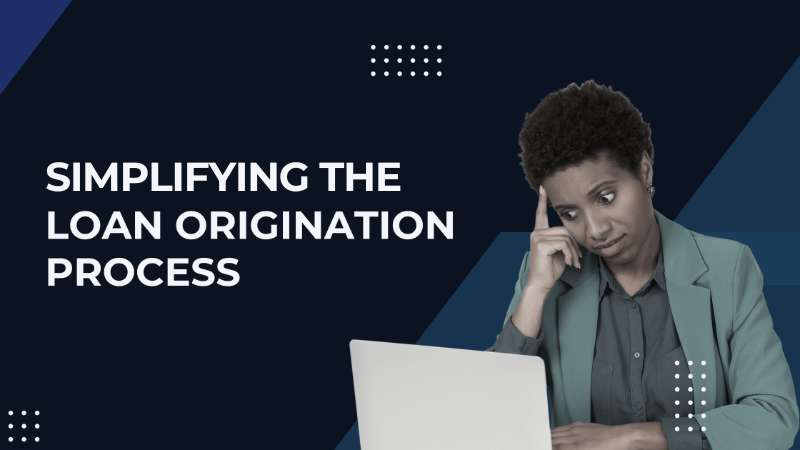As the world leans more into digitization, few business sectors are getting left behind. Commercial lending is no exception. Lenders are seeking ways to automate the loan origination process, increase sales, speed up underwriting and improve efficiency. Because it is so ingrained in the shift, the future of lending is dependent on how well lenders will embrace technology trends in loan origination.
Loan origination is the multi-step process of applying for and obtaining a loan, including all that’s involved in evaluating, approving and disbursing it. Previously, the process relied on manual tasks that often took too long, ended in errors and kept key resources from revenue-producing work. Today’s advancements in loan origination software have given lenders a competitive edge, with stronger customer relations and faster credit decisioning.
How Does Commercial Loan Origination Work?
Origination is a lengthy process and involves several steps. Below is a breakdown of the process and how advanced technology has made it more efficient.
Stage 1: Loan Application
The borrower accesses a secure portal, where they can enter key business details required by a lender and can submit an application, which the lender then receives through the loan origination platform. The borrower has to upload supporting documentation about their company and financial details. The documentation required depends on the type of loan, the lender’s unique requirements and the amount of financing the business is seeking. In some cases, the business and/or owner credit history may also be a factor.
A secure borrower portal which is customized to the lender’s unique criteria and can be accessed from any device helps keep the process moving along smoothly. Plus, having a customer portal you can use to share status updates, important information, next steps and insights elevates the borrower experience and helps onboard the client more quickly.
Stage 2: Pre-qualification
The lender receives initial information about the business, the management and its owners, as well as a financial picture of the borrower’s creditworthiness. This involves manual work on the borrower’s part to provide documents, and on the lender’s part to chase down the documents they need. Smart loan origination software cuts down on the work by directly connecting to accounting and bank systems, and providing a secure platform to provide documents and sensitive information. Where additional paperwork is required, borrowers can view additional requirements, securely upload files of any type, and all data is kept in their digital file for easy access.
During this stage, the lender uses their internal underwriting guidelines and loan program requirements to determine if the borrower will likely qualify for a loan, for what amount, and at what rates. In some types of specialty lending, the lenders look at customers also known as debtors or vendors and their creditworthiness, and in other cases they consider different types of collateral for the loan. Often misunderstood, pre-qualification does not equate to loan approval. The lender still needs to verify all the information provided by the borrower before approving the final loan.
Stage 3: Proposal/Term Sheet
Depending on the type of commercial loan and the amount, many lenders provide what is known as a “Term Sheet” or Proposal, which outlines in general terms the offer the lender is prepared to provide. It is not a loan agreement or contract, and the business is still subject to a full underwriting. It is, however, an offer to see if the business is interested in the terms and to see if the lender should move forward with full processing and approval. Some lenders charge businesses a fee to underwrite or process their loan, others do not. Being able to collect an underwriting fee is also something that can be streamlined by loan servicing software via the borrower’s credit portal.
Stage 4: Application Processing
During processing, a loan application is prepared for full review by an underwriter. This includes collecting and verifying the business information, history, financials, customers, vendors, UCCs, liens and information on the business owners and guarantors. The processor is responsible for ensuring all required information and documentation is complete and accurate before sending to the underwriter, so it’s important to use a system that automatically flags all missing items so that the underwriting team has all the information needed. Smaller lenders may not have anyone processing the information and the underwriter might need to do this on their own, so having a platform to help track all the missing items is key.
Stage 5: Underwriting Process
During underwriting, the lender reviews the application for the borrower’s creditworthiness as well as assesses the collateral that will be used to secure the loan. The underwriter verifies the information provided and requests any additional documentation. The objective of this stage is to determine the risks involved with the loan or deal, the pricing structure, and to set the terms and conditions for the loan that will mitigate potential risks. For larger loans, there may also be various levels of underwriter approvals.
Using an AI-driven solution to automatically run your underwriting checklist enables lenders to quickly spot areas of concern to reduce risk and chances of manual errors.
Stage 6: Credit Memo / Credit Approval Form
The underwriting team usually determines whether the application gets approved, denied or returned to the salesperson or borrower if more information is needed. For larger loans, there could be a credit committee involved who needs to review and approve the business for financing. Underwriters and salespersons are involved in the “write-up” or “credit memo” or “credit approval form,” which get circulated to the credit committee or key decision makers for final approval. Manually working on the credit memo or write-up is very time-consuming. Loan origination software that automatically produces most parts of the credit memo helps the lender approve loans more efficiently, reducing manual work for underwriters and salespersons, and increasing collaboration among lending teams.
For smaller loans, loan origination and underwriting systems can plug in each lender’s unique risk criteria and bring in credit and background reports. They can also send out the Term Sheet and even make automated credit pre-approval.
Loan origination systems that leverage AI can automatically evaluate an applicant’s attributes and provide immediate loan approval for well-qualified applicants. Streamlining decisioning provides businesses with faster approval and quicker access to capital.
Stage 7: Loan Approval
When a loan is approved, the lender provides the borrower with loan terms and conditions, interest rates, monthly payments if applicable, and any fees or charges associated with the loan.
Automating sending out the loan agreements, factoring agreements, master receivables agreements, guarantees, disclosures, and many other loan closing documents is key to better managing the loan closing process.
Utilizing a loan origination platform to automate sending loan agreements and even disclosures can be game-changing for lenders. In many states like California, New York and Florida, special loan disclosures are required to be sent to borrowers. Loan origination systems that can automatically send disclosures and auto-calculate disclosure fees can speed up the process and reduce manual work for underwriters.
Stage 8: Final Approval / Quality Control
Because lending is regulated for many lenders, this stage can be critical. The application may be reviewed by a senior underwriter or a quality control team member who analyzes the loan prior to releasing the funds and ensures that the lender is meeting all applicable regulations and all risks are mitigated. Some lenders are also required to notify borrowers of adverse decisions, and automating that process can also save lenders time and ensure they are meeting compliance requirements.
Stage 9: Loan Funding
Once approved, the application will move to the funding process. Lending origination software can also include underwriting and funding or connect to funding software to provide complete automation along the lending process.
Commercial loan origination is a time-consuming process filled with redundant, manual tasks and an inefficient flow between lenders and borrowers. Automated loan origination software takes the complexity out of it, allowing lenders to do more business and build their portfolios. Decipher’s highly configurable and robust solution was built by lenders for lenders. We know your pain points and strategically constructed a cloud-based platform to streamline the entire origination, underwriting, and onboarding process.
To learn more about our solution, click here.




